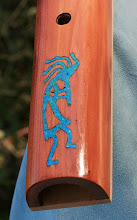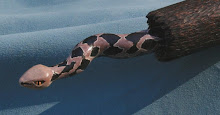***NEW WEBSITE UP AND RUNNING!!!!!!***
www.UglyBoyFlutes.com
(redirects to ooakart.com
as it always has)
 This is the flute as it has pretty much sat since then, with only minor shaping at the 'foot' where the woodpecker was going to go....
This is the flute as it has pretty much sat since then, with only minor shaping at the 'foot' where the woodpecker was going to go....
 The above two shots show my pics of a Downy Woodpecker feeeding, up against what I was 'envisioning' for the flute. Originally the flute was going to be an F#4, but as I honed down the woodpecker and tweaked the tuning, it was much better suited for a G4, up a half step.
The above two shots show my pics of a Downy Woodpecker feeeding, up against what I was 'envisioning' for the flute. Originally the flute was going to be an F#4, but as I honed down the woodpecker and tweaked the tuning, it was much better suited for a G4, up a half step. Voila, the flute finished off with the woodpecker detailed and painted. NOW came another big hurdle...what to do for the block? The main interest is the foot of the flute, and I didn't want a detailed block that would compete with the focus of the woodpecker. Conversely, I didn't want such a simple block design that it detracted from the focus...and so I sat with notebook and pencil and sketched. And sketched. And sketched.
Voila, the flute finished off with the woodpecker detailed and painted. NOW came another big hurdle...what to do for the block? The main interest is the foot of the flute, and I didn't want a detailed block that would compete with the focus of the woodpecker. Conversely, I didn't want such a simple block design that it detracted from the focus...and so I sat with notebook and pencil and sketched. And sketched. And sketched. I've done this with only a very few flutes, where I take scrap wood and glue up a composite shape of the pieces. Above you see scrap Bloodwood and Ebony, my actual pencil sketch (cut out) of the main tail sweep bordered by two 'wing' pieces, once of which you see cut out.
I've done this with only a very few flutes, where I take scrap wood and glue up a composite shape of the pieces. Above you see scrap Bloodwood and Ebony, my actual pencil sketch (cut out) of the main tail sweep bordered by two 'wing' pieces, once of which you see cut out. The three pieces weren't quite wide enough for the flute, so I glued on 'side bars' on the outer edge, knowing I'd sand their width down some. Too, you don't want a pure Ebony bottom exposed over the flue as such a design would lead to quick wet-out...so I thought I'd incorporate the red with the Bloodwood for a bottom choice. The bottom above was rougher than normal as a couple of pieces fractured off, but I knew I'd slap it on the belt sander and flatten it all before adding the Bloodwood.
The three pieces weren't quite wide enough for the flute, so I glued on 'side bars' on the outer edge, knowing I'd sand their width down some. Too, you don't want a pure Ebony bottom exposed over the flue as such a design would lead to quick wet-out...so I thought I'd incorporate the red with the Bloodwood for a bottom choice. The bottom above was rougher than normal as a couple of pieces fractured off, but I knew I'd slap it on the belt sander and flatten it all before adding the Bloodwood. With some shaping and careful sanding, the block took on an elegant sweeping design of a bird of sorts, with tail and wings, the Ebony and Bloodwood repeating the colors in the Downy Woodpecker. Only one thing left to do.....
With some shaping and careful sanding, the block took on an elegant sweeping design of a bird of sorts, with tail and wings, the Ebony and Bloodwood repeating the colors in the Downy Woodpecker. Only one thing left to do..... The new G4 Downy Woodpecker flute fresh off the press as of today, as I write. Still a couple of more finish coats to put on, and the most minor of touch-up...goes to prove that I don't just whip these 'kids' out without a lot of thought and intentional thought! This one is close to a record, I'll admit. Worth the wait, though, eh? ;-)
The new G4 Downy Woodpecker flute fresh off the press as of today, as I write. Still a couple of more finish coats to put on, and the most minor of touch-up...goes to prove that I don't just whip these 'kids' out without a lot of thought and intentional thought! This one is close to a record, I'll admit. Worth the wait, though, eh? ;-) Now, you may not be aware of how unusual that is, an Ebony flute. First and foremost you're talking $$$ as good Ebony starts at $75/ board-foot. Too, setting aside the expense, the sound you get from such a dense wood is in it's own little category.
Now, you may not be aware of how unusual that is, an Ebony flute. First and foremost you're talking $$$ as good Ebony starts at $75/ board-foot. Too, setting aside the expense, the sound you get from such a dense wood is in it's own little category. And you may think Ebony is pure black, but that's not the case. Most Ebony has chocolaty ribbons in it, but when oiled and finished most of it goes very dark, indeed.
And you may think Ebony is pure black, but that's not the case. Most Ebony has chocolaty ribbons in it, but when oiled and finished most of it goes very dark, indeed. Meet "Nighthawk", named for the actual bird. This mid "A" (A4) is 20.5" long with a composite block of 3 thinner Ebony strips, with the end result being a bird silhouette that for me resembles a nighthawk.
Meet "Nighthawk", named for the actual bird. This mid "A" (A4) is 20.5" long with a composite block of 3 thinner Ebony strips, with the end result being a bird silhouette that for me resembles a nighthawk. The pictures are with the flute sanded and finished with one coat of Walnut Oil....I may re-oil and finish with wax, or may try a shiny poly coat on it, though Ebony can be fickle with finishes.
The pictures are with the flute sanded and finished with one coat of Walnut Oil....I may re-oil and finish with wax, or may try a shiny poly coat on it, though Ebony can be fickle with finishes. I suppose I need to qualify a 100% Ebony flute...the block actually has a 1/16" layer of Poplar on the bottom to help absorb a little moisture, as Ebony simply doesn't....should help this flute avoid super-fast 'wet-out' since Poplar will absorb some moisture. I coated the edge with a Sharpie to darken it!
I suppose I need to qualify a 100% Ebony flute...the block actually has a 1/16" layer of Poplar on the bottom to help absorb a little moisture, as Ebony simply doesn't....should help this flute avoid super-fast 'wet-out' since Poplar will absorb some moisture. I coated the edge with a Sharpie to darken it!

